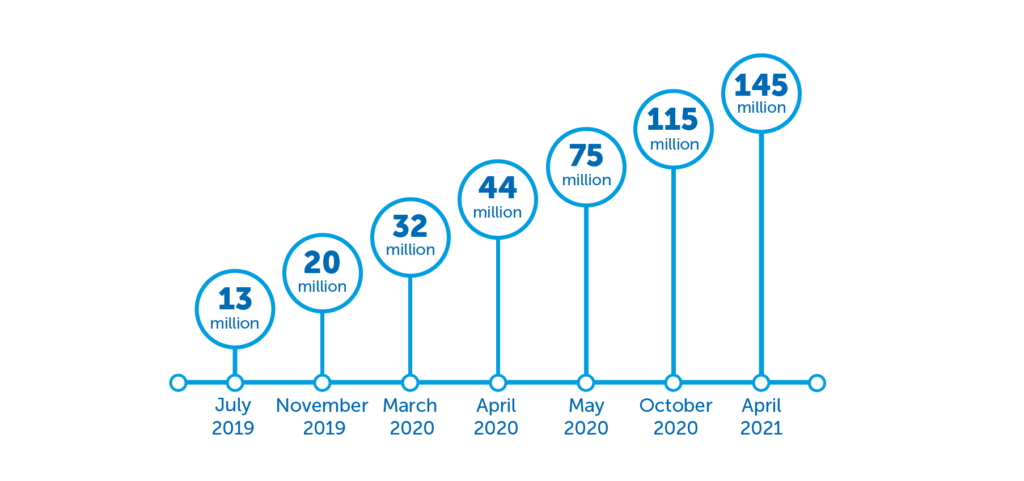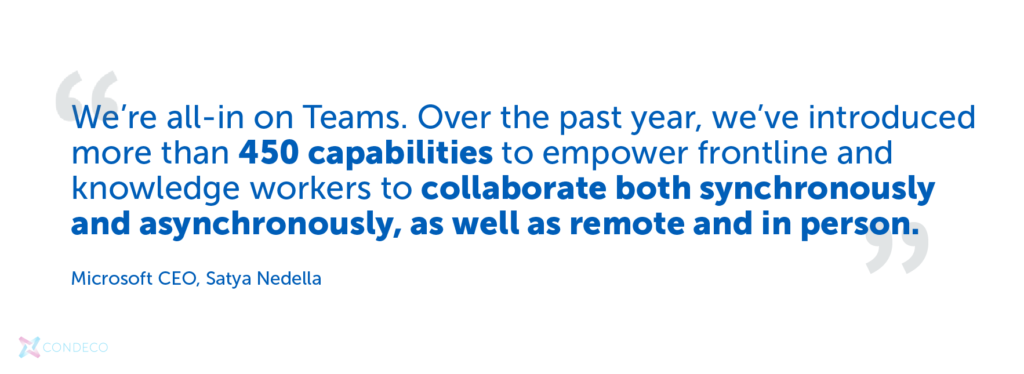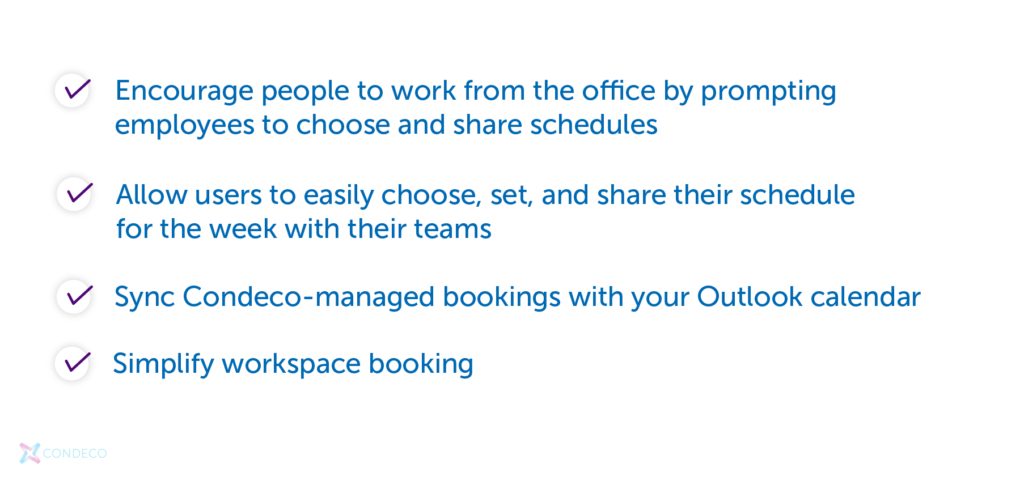
Microsoft Teams has seen a meteoric rise in adoption by companies and employees. We dive into the numbers to better understand why.

Launched in 2017, Microsoft Teams has become a leading unified communication platform for enterprise employees and businesses alike. Teams is an all-encompassing communications experience platform centered on our daily work and business efficiency needs across: personal and group chat, phone calls, file sharing, live, real-time collaboration in applications, webinars, and much more.
In the last few years, Microsoft Teams has experienced incredible growth spurred by the rapid and necessary adoption of hybrid and remote work. The world didn’t just survive an enforced period of flexible working during the pandemic—it thrived on it. As a result, employees are exploring new hybrid working models where they call the shots on where and when they work.
In 2021, analyst firm Gartner placed Microsoft in the leadership sections in two of its Magic Quadrant research reports: 2021 Gartner Magic Quadrant for Unified Communications as a Service (UCaaS) and the Gartner Meeting Solutions Magic Quadrant. It was the third time the company was in the UCaaS report as a leader and the fifteenth year as a leader in the widely heralded meeting solutions research.
Vice president of Microsoft Teams, Nicole Herskowitz, recently said in a post about the recognition: “Many large organizations around the world are using Microsoft Teams: 124 organizations have more than 100,000 users of Teams, and nearly 3,000 organizations have over 10,000.”
Here’s a closer look at adoption of Microsoft Teams over the last few years.
Microsoft Teams user adoption rates are strong. Look at the aggregate numbers.

In April of 2021, Microsoft reported there were 145 million daily active users. In July of 2021, the software giant began posting monthly active users of 250 million. By the end of 2021, that number blossomed to over 270 million monthly active users, according to data from the Business of Apps.
The company has clarified the switch from reporting daily active users and monthly active users. Monthly users could also include part-time employees and contractors that are not necessarily using Teams every day. Per Microsoft, a monthly active user is the number of distinct users that perform an intentional Teams action, such as chatting, posting a file, making a call, etc. in the last 28 days. This includes paid, trial, and free customers. Makes sense.
Yet, Teams had an even more spectacular growth expansion only a few years prior. Teams use grew from 20 million daily active users in 2019 to 75 million by the end of Q2 in 2020. By the end of Q4 2020 that number grew to 115 million, according to Statista.
That’s a 475% increase.

[Source: Mio]
“Microsoft Teams growth has been staggering, not just the raw DAU numbers, but the speed with which individual large companies have rolled out and adopted, mainly due to the pressure of the pandemic and remote working,” says Tom Arbuthnot, Microsoft MVP and Principal Solutions Architect at Modality Systems, according to a blog post by Patrick Watson of Cavell Group. Arbuthnot pens his own blog dubbed Tom Talks which follows Microsoft Teams and Microsoft 365 very closely.
Arbuthnot went on to say: “Yet, many organizations are just at the beginning of truly maximizing their investment in Teams, moving beyond just meetings and chat to true collaborative working and telephony.”
Speaking of telephony, the company reported in July 2022 that Microsoft Teams Phone has over 12 million PTSN users which is nearly double the number from a year ago.

“We’re all-in on Teams. Over the past year, we’ve introduced more than 450 capabilities to empower frontline and knowledge workers to collaborate both synchronously and asynchronously, as well as remote and in person,” says Microsoft CEO Satya Nedella.
Go deeper. Read our post “5 reasons why Microsoft Teams is the best for employee collaboration.”
Why are Microsoft Teams adoption rates and usage so high? Integration with Microsoft applications and attractive Microsoft 365 licensing costs.

There are several key reasons that an estimated 91% of Fortune 100 companies use Microsoft Teams. First, there is the built-in integration with a plethora of its software including the Microsoft Office essentials Excel, Word, PowerPoint, and others. Plus, there is a benefit for large enterprises having economy of scale with licensing. For many organizations that license Microsoft 365 at scale, Teams use has no additional cost.
“Top two key drivers behind rise in adoption rates are 53.3% of enterprises citing integration with Microsoft applications and 33% of enterprises citing ease in integrating licensing costs,” finds Tone Software in a post about the impact of Teams on the unified communications market.
Integration does not stop with Microsoft’s own existing software either. Many organizations and third-party application providers are building their own apps to work with Teams and others are expanding their ability to integrate and work with the collaboration software via APIs.
“ISVs, from Adobe to Workday, have built deep integrations with Teams. And more than 100,000 companies, including Johnson & Johnson, Lumen Technologies, and Progressive Insurance, have deployed custom line of business apps in Teams,” says Microsoft CEO Satya Nedella in the July 2022 earnings transcript. “All-up, the number of third-party and LOB apps with active usage increased by 40 percent year-over-year.”
Why Microsoft Teams adoption rates continue to expand: Microsoft’s investment and the ease of a more unified, collaborative experience.
Among the many reasons that Teams has seen its meteoric rise is the fact that Microsoft itself is heavily invested in this technology. There was a time in 2016 that the company was rumored to be in talks to acquire Slack for $8 billion but did not purchase the chat technology. Evidently, CEO Satya Nadella and Bill Gates advocated against that purchase. Between acquisitions of Yammer, Skype, Lync, and others, the company felt it could develop its own singular unified communications platform. And it did with Teams.
“Microsoft sells a vast array of applications, products and software so for any one application to stand out is a strong sign that Microsoft sees long term value in it,” says Loryan Strant from Insync Technology, a member of the Modern Workplace Alliance. “Unlike other much-hyped products, Microsoft have made a significant investment in resources, training, certification and devices with Microsoft Teams.”
Slack was eventually acquired by Salesforce in 2021 for $28 billion dollars but lags the user adoption rates of Teams. Slack reports 18 million daily active users today used by 156,000 organizations, according to the Business of Apps. By the last count in 2020, Microsoft Teams is used by over 1 million organizations.
“The integration of Microsoft Teams is ground-breaking; it has tentacles everywhere,” says Strant. “As a workforce, we are accustomed to arriving in the office, switching on a PC and checking our emails. With the use of Microsoft Teams which allows real-time conversations, file sharing, project planning and more, people will start forgetting to check emails. They’ll keep Microsoft Teams open all day, not Outlook. This is a massive shift to the way we work.”
Connect and Collaborate with Condeco + Microsoft Teams

Powered by Condeco Microsoft 365 integration, our new app for Teams helps everyone across your company work smarter, together.
- Encourage people to work from the office by prompting employees to choose and share schedules
- Allow users to easily choose, set, and share their schedule for the week with their teams
- Sync Condeco-managed bookings with your Outlook calendar
- Simplify workspace booking
Microsoft Teams 365 Integration | Condeco Software
See for yourself how Condeco and Microsoft Teams work smarter together today.



